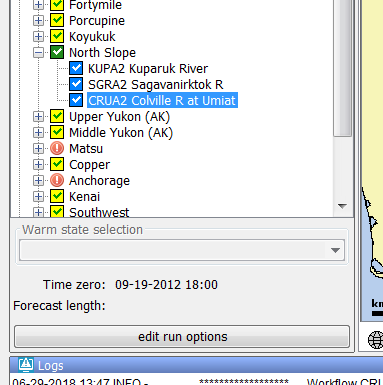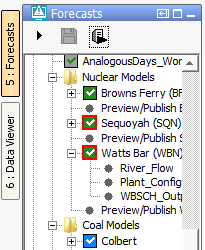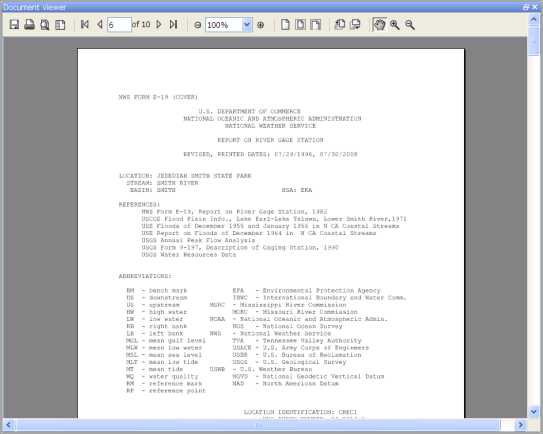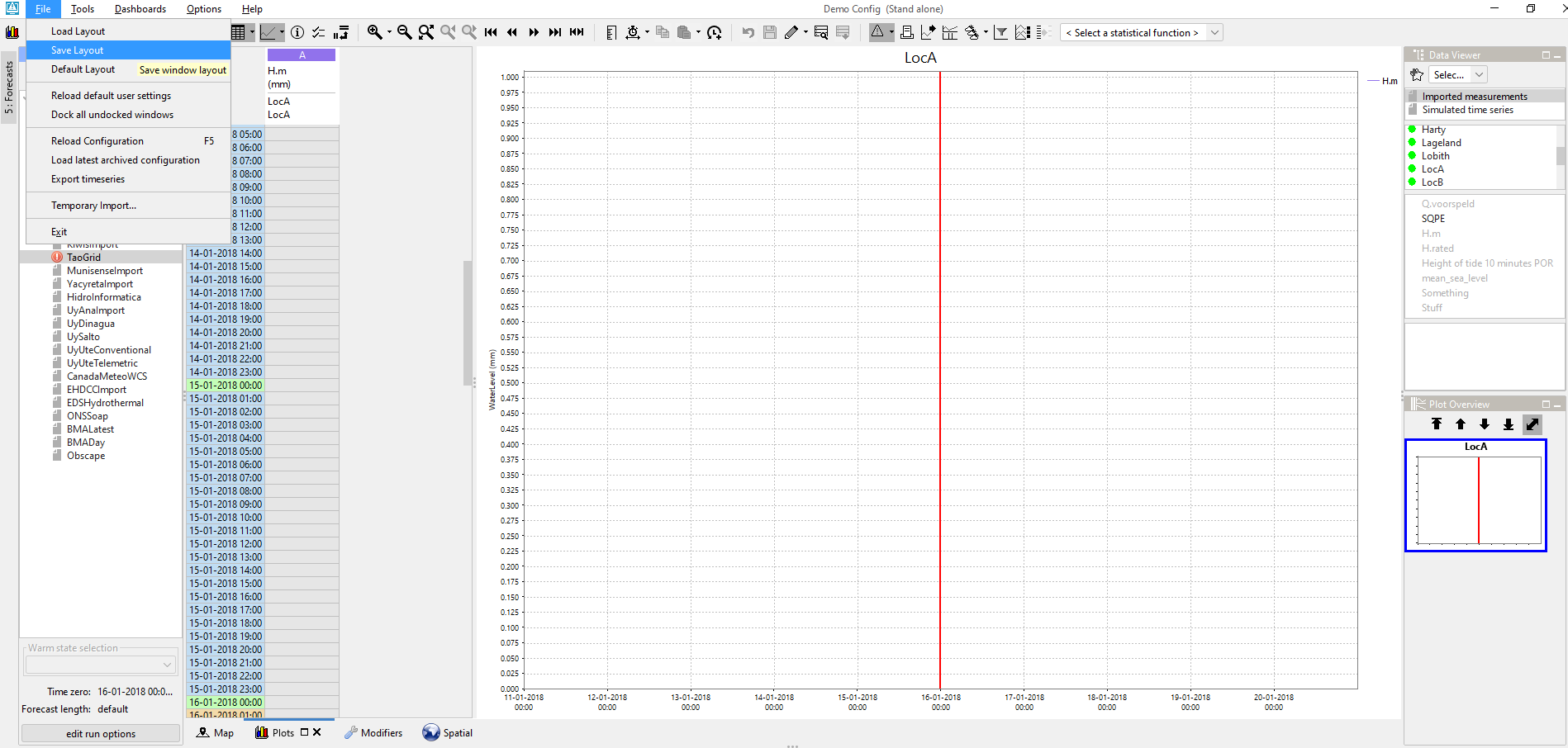...
The IFD (Interactive Forecasting Displays) consists of several panels. Each of these panels has a specific role in the process of creating a forecast with the IFD. In this chapter the functionality of each panel in the IFD will be explained.
In chapter How to create a forecast with the IFD will be explained with a use case how a forecast can be created with the IFD by using the combined functionality of the separate panels.
Forecast panel
The forecast panel (indicated in yellow rectangle above) plays a central role in creating a forecast in the IFD. The forecast panel shows a tree with all the forecast points for a region and a logical grouping of these forecast points.
It is also possible to show the work process of a forecaster in the forecast panel. The forecast panel consists of three main sections each of them will be explained in detail in the coming sections.
...
| Icon | Action | Visible | Enabled | Available since | |
|---|---|---|---|---|---|
| Switches to IFD between read-only mode and edit-mode | when the option <enableAutoRun> is set to true. | always | |||
| Starts the workflow of the node in IFD-mode. | always |
| |||
| promotes a local IFD run to a server run. | always | when the node has an IFD-run and when the option <saveLocalRunEnabled> is set to true. | |||
| starts a workflow in server mode. | always |
| |||
| starts the secondary workflow of the selected node | when any node has a secondary workflow configured. | when a node is selected which has a secondary workflow configured. | 2018.01 | ||
If the button is selected the threshold icons will be shown instead of the regular run status icons | always | always | 2019.02 | ||
| If this button is selected a modifier icon will be shown for a topology node if active modifiers are visible in the modifiers panel if that topology node is selected. This means that if you disable for a topology node that modifiers are visible in the modifiers panel that the modifier icon will also not be visible. | always | always | 2020.01 |
| Icon | Action | Visible | Enabled | Available since | |
|---|---|---|---|---|---|
| Switches to IFD between read-only mode and edit-mode | when the option <enableAutoRun> is set to true. | always | |||
| step to the next leaf node in the topology tree | always | always | |||
| start a workflow in IFD mode | always | when a node is selected for the option <localRun> is set to true | |||
| start all the workflows of the children of the group node in IFD-mode | always | when a group node is selected | |||
| starts a workflow in server mode. | always |
| |||
updates the system time to the current time. | always | always | |||
| starts the secondary workflow of the selected node | when any node has a secondary workflow configured. | when a node is selected which has a secondary workflow configured. | 2018.01 | ||
| If this button is selected a modifier icon will be shown for a topology node if active modifiers are visible in the modifiers panel if that topology node is selected. This means that if you disable for a topology node that modifiers are visible in the modifiers panel that the modifier icon will also not be visible. | always | always | 2020.01 |
...
- Running,
- Pending,
- Failed,
- Succesfull
- Succesfull but the time zero of the run is different then the time zero of the IFD,
- Succesfull but the workflow needs to be rerun because the state selection was changed, a modifier was created after the run or the forecast length is changed,
- A combination of the 2 statuses above.
Below an overview of all the combinations which are available for a succesfull run (local or server).
...
In the example below a server run has run succesfully run for node North Slope. For the leaf nodes KUPA2, SGRA2 and CRUA2 a successfull IFD run was executed.
Succesfull run Successful run with a different time zero
If the time zero of a node is different than the time zero which was used in the succesfull successful run then the icons will be different.
...
The icons are grey instead of green and blue and the check marks are now blue and green.
Failed run
A failed run is indicated by an icon with a exclamation mark . If the time zero of the failed run is equal to the time zero of the node the exclamation mark will be red otherwise it will be black.
...
When a modifier is made at a node with a local successfull successful run then the icon will change to a yellow icon with a blue check (local run) or yellow icon with a green check (server run)to indicate that the workflow of that node needs to rerun.
...
then the icon will change into a grey icon with a yellow checkmark (server runs and local runs). Below a few examples.
Red outline
As of 2016.01, The IFD status icon can be surrounded by a red outline. See figure below. This red outline surrounding the IFD status icon indicates that the workflow task completed but not all of the data has been synchronised back to the operator client. This red outline feature is disabled for DDA clients as it pertains only to synchronisation in LDS clients.
Task properties panel
The bottom section of the forecast panel can be used to select the task properties of a node.
...
- State selection,
- Time zero,
- Forecast length,
- User description for the workflow,
- What-if scenario.
The majority of these settings can be adjusted in the bottom section of the panel.
...
The upper part of the display gives an overview of the modifiers created for the currently selected node in the forecaster panel. When a modifier is selected in this panel, the details will be shown in the lower part of the panel. It also allows the user to make mods active and inactive with the checkbox in the column Active. A mod can be deleted by pressing the cross icon and a copy can be made pressing the copy-icon.It also allows the user to make mods active and inactive with the checkbox in the column Active. When a modifier is made locally, it get's a salmon background color. When it is saved to the server (by running the associated WF on the server), it gets a green background color.
A mod can be deleted by pressing the cross icon. If you have made a local change to a saved modifier, only the local change will be deleted when you press the cross. The background color will change back from salmon to green. If you delete it again, the saved modifier will be deleted as well. (Note, in a SA the behavior is different. In a SA a single delete action deletes the entire modifier.) If you make use of the Run Info panel (see Explorer Tasks, with <taskClass>nl.wldelft.fews.gui.plugin.runinfo.RunInfoPanel</taskClass>), this will show both the saved and local modifiers, so you can compare them directly.
The copy-icon copies the modifier.
Spatial display
Since 2019.02, there are modifier types which are used to modify grid time series. These spatial modifiers need to be created through the spatial display instead of the modifiers panel. More information on how to create spatial modifiers in the spatial display is found at User Guide > 05 Spatial Display > Creating Spatial Modifiers.
...
If the forecasterHelperDirectories is not configured, the INFORMATION_PANEL_FOLDER property defined in the global.properties will be used instead.
To add the Forecaster help panel and document viewer to the Delft-FEWS explorer, please add the following tasks to Explorer.xml. The <predefinedDisplay> "documents" (or taskClass ForecasterAidDocumentPanel) is the main window, which displays the content of the documents in the explorer. The ForecasterAidSelectionPanel is a so called toolwindow, displaying a list of all available documents (in the folder linked to the node). The content of this Selection panel depends on which node is selected in the Topology, and is updated automatically when a different node is selected.
...
When one of the files is selected in this panel the content of the selected file is shown in the document viewer. The document viewer is a dockable window in the centre of the Delft-FEWS Operator Client (or SA) GUI.
When a text file is selected, it can also be edited. To facilitate this an edit and save button are displayed above the document when selecting a text file.
...
The file-menu also provides an option default layout. By selecting this option the default layout can be reloaded.























